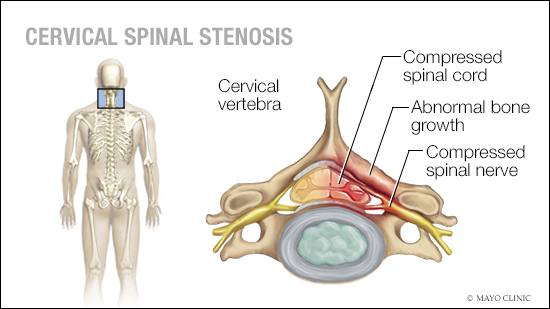-
Mayo Clinic Q and A: Treating cervical spinal stenosis

DEAR MAYO CLINIC: I was diagnosed with cervical spinal stenosis after several months of neck pain, along with weakness, numbness and tingling in one arm and hand that kept getting worse. My health care provider recommends surgery, including spinal decompression and fusion. Is there a less-invasive treatment I could try before surgery?
ANSWER: Although it is possible that nonsurgical treatment may be reasonable for you, it sounds likely that surgery is in your best interest. That decision should be based on several factors, though, including the severity of your symptoms and whether the condition is affecting your spinal cord function.
Spinal stenosis happens when the main channel for the spinal cord — called the central spinal canal — or the openings for individual nerve roots in your spine become narrowed, causing pressure on nerve tissue. Spinal stenosis often is a result of aging and the formation of bone spurs from arthritis. Many people also are born with a narrow spinal canal, making them more prone to stenosis as they age.
When spinal stenosis affects the spine in your neck, called the cervical spine, it can affect a single arm (as in your case) if an isolated nerve root is compressed, or it may affect the entire body if the spinal cord is involved. The spinal cord is a vital structure because all the movement-related messages your brain sends to your body, as well as all the sensory messages your body generates below your neck, travel through the cervical spinal cord.
Cervical spinal stenosis often triggers pain; weakness; numbness; or clumsiness in a hand, foot, arm or leg. It also can cause problems with walking and balance. If left untreated, these symptoms may worsen, and additional symptoms, such as bowel or bladder problems, may develop.
When spinal stenosis is suspected, a detailed medical history and physical exam are necessary to find the cause of the symptoms. Imaging with MRI typically is performed to confirm the diagnosis and localize the stenosis. X-rays and CT scans usually are part of the evaluation, too, especially when there is significant neck pain, a spinal deformity or history of trauma. An electromyogram and blood tests also may be needed to confirm that symptoms are a result of spinal stenosis.
Spinal stenosis treatments that don’t involve surgery include self-care measures, medication, physical therapy and steroid injections. These treatments often can relieve symptoms of mild spinal stenosis. But for individuals like you who have complaints that grow steadily worse, surgery may be necessary to prevent permanent spinal cord or nerve root damage, and relieve — or at least stabilize — symptoms.
When surgery is necessary, the goal is to create more space for the nerve tissue. During spinal decompression, a surgeon removes the bone, ligament or disc that’s putting pressure on the spinal cord or nerve roots. Spinal fusion is performed if the spine is deformed or unstable, or if the spine’s alignment and stability are compromised by decompression.
Spinal fusion involves reinforcing the spine by linking two or more of the vertebrae together with a bone graft. Metal implants are used to maintain proper alignment and aid bone fusion. Spinal fusion is needed more often when stenosis surgery is performed in the cervical spine because that area tends to become unstable as a result of spinal decompression.
In some cases, an artificial disc can be inserted instead of performing a fusion to allow the vertebrae to continue to move normally. But that approach is only appropriate for people who have a well-aligned spine without instability or significant arthritis. Occasionally, the cervical spine can be decompressed without fusion, especially when opening it from the back instead of the front.
Surgery for spinal stenosis usually is not a matter of urgency, so take time to discuss your concerns with your health care provider. Together, you can review the goals, risks and benefits of surgery, and decide what’s best for you. Results of surgery for spinal stenosis generally are excellent when the operation is performed for the right indications and the correct procedure is chosen. — Dr. Bradford Currier, Orthopedic Surgery, Mayo Clinic, Rochester, Minnesota
****************************
Related Articles
- Spinal stenosis / mental health benefits of tidying up / helping cancer patients quit tobacco: Mayo Clinic Radio published 3/31/19
- Mayo Clinic Radio: Spinal stenosis published 3/28/19







